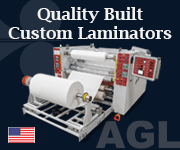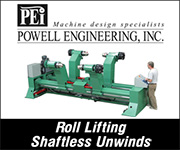Featured Stories
-
-
Static Eliminators for Unwinding, Rewinding and Slitting
For an unwinding or a rewinding roll, where can we put a static dissipater so that it works? -
News | New Products
-
Avery Dennison Completes Bonding Study with Fostek™ Corporation’s Foam Products
Avery Dennison Performance Tapes has released the sixth in a series of bonding studies that make it easier for converters to evaluate the performance of Avery Dennison Core Series™
-
UPM Adhesive Materials Invests in Malaysia Factory to Accelerate Growth in Southeast Asia
UPM Adhesive Materials, formerly known as UPM Raflatac, is investing in a new, state-of-the-art coating line and other facility and material handling upgrades
-
Smithers Forecasts Tariffs to Reshape $1.5 Trillion Global Packaging Market by 2030
U.S. tariff policies could reshape the global packaging industry, with potential impacts reaching into the tens of billions of dollars
-
Siegwerk Strengthens Coating Business by Acquiring Chemicals Producer Allinova
Siegwerk Druckfarben AG & Co. KGaA, one of the leading international suppliers of printing inks and coatings for packaging applications and labels
-
Tom Tripp joins Domino as Digital Printing Sales Manager for Corrugated
Domino continues to grow its digital printing business with the addition of Tom Tripp, as Digital Printing Sales Manager for Corrugated.
-
PAC Strapping Products to Highlight Innovative Strapping Solutions at The Clean Show
PAC Strapping Products, a leader in the strapping and packaging industry, will exhibit its advanced packaging solutions at The Clean Show 2025
-
Meech launches 906 Hyperion 24V Power Supply Unit for packaging and converting applications
Meech International has introduced the 906 Hyperion 24V Power Supply Unit (PSU), a compact high-voltage AC power supply with 24VDC input
Expert Advice
Web Line Knowledge Offers a Competitive Advantage
- Published: February 01, 2002, By Timothy J. Walker, TJ Walker & Assoc. Inc.
Web lines are the backbone of the converting industry — the equipment used in converting paper, film, foil, and other webs into valued product. In this monthly column, I will try to help converters understand how web lines work, how they can be improved, and mainly, how this knowledge can increase profits.
The primary motive for increased web line knowledge is defect prevention. The four main defect areas are abrasion, wrinkling, deformation, and breakage. Each can take a bite out of yields; in combination, they can be catastrophic.
To prevent these defects, we must understand how webs and web line equipment work, and how the two interact. Web line knowledge starts with web handling: how to unwind, transport, and rewind web materials. We must be able to handle the web before we can process it. Topics include:
Web Properties: Tailor web processes to web material. We must consider the web's mechanical behavior and limits, surface characteristics, and interaction with the environment.
Roller Design: The primary “hand” on the web is the simple rotating cylinder. Rollers should be designed based on web surface, tension, and speed.
Nips: This includes the advantages, applications, and pitfalls associated with creating high pressure on a web sandwiched between two rollers.
Traction: The “grip” of web handling cannot be assumed. An unintentional sliding web can be as catastrophic as a sliding automobile.
Tension Control: The tension control system determines length, registration, width, and speed. More importantly, web tension magnitude and variation are at the root of all four major web defect areas.
Lateral Position Control: Web tracking relative to machine centerline may involve the “normal entry rule,” variable diameter rollers, or sophisticated closed loop control.
Winding and Unwinding: Many operator hours are spent tending winders. Winders must be designed based on material properties, roll geometry, cores, roll splicing, and operator interaction.
Floatation: Though not required by all web lines, it is used to turn a web without touching one or both sides. While infrequently applied due to cost, noise, and instability, floatation should be included in your web line design bag of tricks.
Web line knowledge is of most value when you apply it to more complex web-dependent systems:
Controls: Web spring constants and wound-roll inertial variations make web control unique. Lateral control is limited by the web's mechanical limitations.
Safety: Process engineers provide input into personnel safety. Government agencies and industry associations provide guidelines, but line experience will make safety measures effective and convenient.
Auxiliary Equipment: Systems intimately integrated into the web line commonly are the domain of the web line engineer. These systems include web cleanliness, slitting, sheeting, stacking, and folding.
Process Interaction: This is what it's all about. Web lines are built to process the web. Coating is not just fluid handling, drying is not just air handling, and laminating is not simply normal pressure. All web value-adding processes rely on a well-behaved web.
Process Integration: This is one of the advantages of web lines and continuous processing. Winding and unwinding always involve some waste. Integrating process steps into a single web line reduces costs, increases yield, and improves productivity.
That last part sounds like improved profits. And you thought this was just about the technical stuff!
This month's column provides a framework for future web line discussions. I would appreciate your input on where you would like this column to go and how it can be valuable to you. Please write or call me with your ideas for topics to discuss or debate.
Timothy J. Walker has 20+ years of experience in web handling processes. He specializes in web handling education, process development, and production problem solving. Contact him at 314/323-6256; tjwalker@tjwa.com.






















